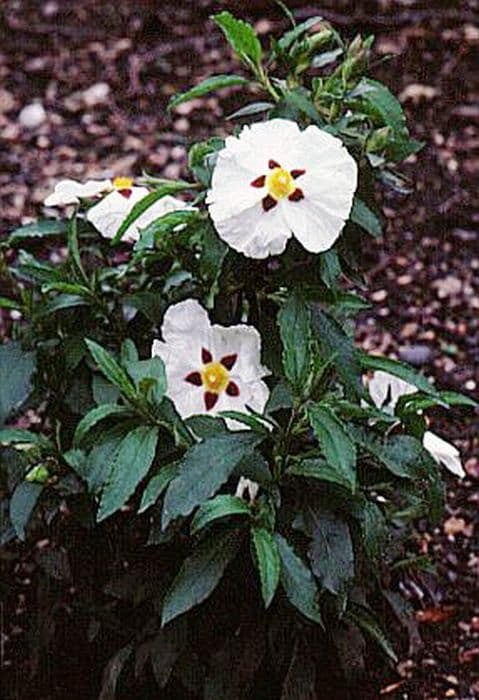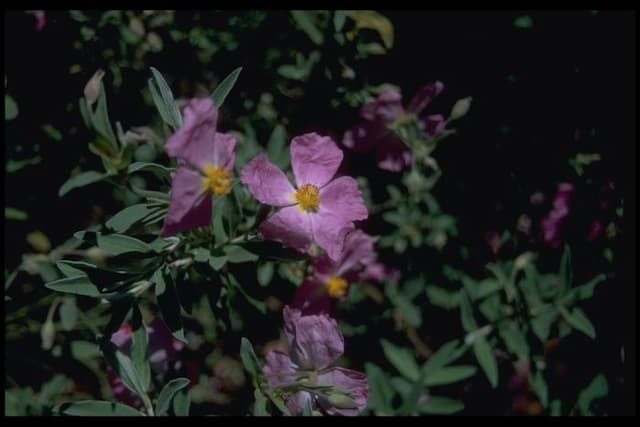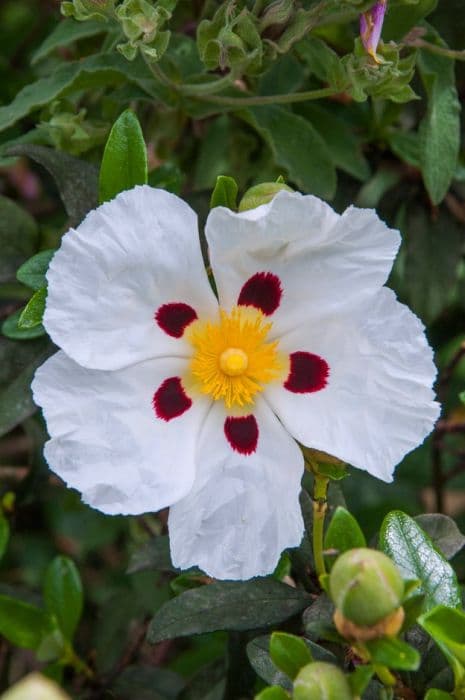Cyprian Rock Rose Cistus × cyprius var. ellipticus 'Elma'

ABOUT
The Cistus × cyprius, commonly known as the rockrose, 'Elma' variety is an evergreen shrub known for its showy flowers and textured foliage. It bears large, showy blooms which are predominantly white with a conspicuous maroon spot at the base of each petal, giving the flowers a distinct appearance. These petals have a slightly crinkled texture, which adds to their ornamental value. The leaves of the 'Elma' variety of rockrose are a deep green color and have an elongated elliptical shape. These leaves often possess a slightly sticky texture, and their arrangement on the branches creates a dense, bushy look for the shrub. This plant is hardy and drought-tolerant once established, making it a popular choice for gardens with a Mediterranean feel. It has a robust nature and the foliage provides year-round interest, although it is the spring and summer months when the rockrose truly comes into its own with its striking floral display.
About this plant
 Names
NamesFamily
Cistaceae
Synonyms
Cyprus Rockrose, Elma Rockrose
Common names
Cistus × cyprius var. ellipticus 'Elma'.
 Toxicity
ToxicityTo humans
Rockrose is generally not known to be toxic to humans. There are no well-documented cases of poisoning or serious consequences from ingesting parts of the plant. It is always advisable to exercise caution and avoid ingesting plants that are not known to be edible, as individual reactions can vary.
To pets
Rockrose is not commonly listed as toxic to pets. There are no specific symptoms of poisoning associated with ingestion of rockrose by pets. However, as with any non-food plant, ingestion can potentially cause mild stomach upset in some animals. If you suspect your pet has eaten a large amount of the plant and is showing signs of distress, consult with a veterinarian.
 Characteristics
CharacteristicsLife cycle
Perennials
Foliage type
Evergreen
Color of leaves
Green
Flower color
White
Height
3-5 feet (0.9-1.5 meters)
Spread
3-5 feet (0.9-1.5 meters)
Plant type
Shrub
Hardiness zones
8
Native area
Mediterranean
Benefits
 General Benefits
General Benefits- Ornamental Appeal: Cistus × cyprius, commonly known as the Cyprus Rockrose, has attractive, large, pink or white flowers with a striking yellow center, enhancing garden aesthetics.
- Drought Tolerance: As a Mediterranean plant, it is highly resistant to dry conditions, making it suitable for xeriscaping or gardens with water restrictions.
- Low Maintenance: Cyprus Rockrose requires minimal care, thriving in poor soils with little need for fertilization or pruning, making it ideal for low-maintenance landscapes.
- Rapid Growth: It has a fast growth rate, quickly filling in garden spaces and providing a full, lush appearance in a short period of time.
- Erosion Control: Its root system helps stabilize the soil, making it useful in preventing erosion on slopes and banks.
- Wildlife Attraction: Its flowers attract pollinators such as bees and butterflies, supporting local biodiversity.
- Sun Tolerance: This plant tolerates full sun conditions, making it versatile for sunny locations where other plants may struggle.
- Deer Resistance: Cyprus Rockrose is generally resistant to deer, which can be beneficial in areas where deer predation is a problem for other garden plants.
- Fire Retardance: The plant is acknowledged for its fire-retardant properties, often used in fire-prone areas as part of a defensible space landscaping strategy.
 Medical Properties
Medical PropertiesThis plant is not used for medical purposes.
 Air-purifying Qualities
Air-purifying QualitiesThis plant is not specifically known for air purifying qualities.
 Other Uses
Other Uses- Cistus × cyprius var. ellipticus 'Elma', commonly known as the Rockrose, can be used for dye extraction. The flowers and leaves contain a resin that has been traditionally used as a source of dye for fabrics.
- Is an excellent choice for fire-resistant landscaping. Rockrose is valued in fire-prone regions for its fire-resistant properties, acting as a protective barrier for homes and wildlife when used in strategic plantings.
- Serves as an ornamental addition to bonsai gardens. The Rockrose's small leaves and attractive flowers make it suitable for training as a bonsai plant, offering an alternative aesthetic for enthusiasts.
- Can be utilized as an ingredient in perfumery. The resinous fragrance of the Rockrose is sometimes used to create aromatic compositions in the perfumery industry.
- Acts as a cover crop in agricultural settings. Because of its hardiness and fast growth, the Rockrose can be planted to protect soil in between the growing seasons of other crops.
- Is used in the production of eco-friendly soaps. The resins and oils from the Rockrose add fragrance and potentially antioxidant properties to natural soap products.
- Provides nectar and pollen for bees and other pollinators. Planting Rockrose in a garden contributes to the health of the local bee population by providing them with additional food sources.
- Serves as a natural boundary or hedge. Rockrose can be grown in rows to form a dense, low hedge that redefines property lines with an ornamental touch.
- Works as a companion plant in vineyards. Some winemakers plant Rockrose among their grapevines, believing it contributes to the terrain's biodiversity and might have beneficial effects on the taste of the wine.
- Can be used in crafting for its decorative flowers. The attractive flowers of the Rockrose are sometimes dried and used in potpourri or other decorative crafting projects.
Interesting Facts
 Feng Shui
Feng ShuiThe Rockrose is not used in Feng Shui practice.
 Zodiac Sign Compitability
Zodiac Sign CompitabilityThe Rockrose is not used in astrology practice.
 Plant Symbolism
Plant SymbolismUnfortunately, I am unable to provide a symbolic meaning list for Cistus × cyprius var. ellipticus 'Elma' as it is not a widely recognized plant with established symbolic meanings. If you are looking for symbolism of the more general "Rock Rose" (Cistus), which is a common name for plants in the Cistus genus, I could provide information on that instead.
 Water
WaterThe Cistus, commonly known as the Rockrose, requires minimal watering once established. In general, watering deeply once or twice a month during dry periods is sufficient. It's important to avoid overwatering, as Rockrose prefers well-draining soil conditions and can be prone to root rot if left in soggy soil. During the first growing season, water enough to keep the soil consistently moist to help the plant establish its root system, which may mean watering once a week. After it is established, the amount of water can be reduced. You can use approximately 1-2 gallons of water per plant for each watering session.
 Light
LightThe Rockrose thrives in full sun conditions, meaning it requires a minimum of six hours of direct sunlight daily. The best spot for this plant is in an area where sunlight is abundant. It is suited to grow in a south-facing location if planted indoors to ensure adequate light exposure. Avoid placing it in deep shade, as this can result in leggy growth and fewer flowers.
 Temperature
TemperatureThe Rockrose is hardy and can tolerate a wide temperature range, from about 20 degrees Fahrenheit in the winter to well over 90 degrees Fahrenheit in the summer. However, the ideal temperature conditions for the plant fall within the moderate range of 50 to 75 degrees Fahrenheit. It's important to protect the plant from extreme cold and frost, which could damage or kill the plant.
 Pruning
PruningPruning of the Rockrose should be done to shape the plant, remove any dead or damaged branches, and encourage a fuller growth habit. The best time to prune is immediately after the blooming period, as pruning too late in the season can remove next year's flower buds. Light pruning can be performed annually, but avoid extensive cutting back as the plant may not recover well from heavy pruning.
 Cleaning
CleaningAs needed
 Soil
SoilThe Rock Rose (Cistus × cyprius 'Elma') thrives best in well-draining soil that is sandy or gritty, amended with compost or other organic matter. The ideal pH range for Rock Rose plants is slightly acidic to neutral, around 6.0 to 7.5. A mixture of one part sand or perlite to two parts garden soil and one part compost or peat moss would create a suitable environment for this plant's growth.
 Repotting
RepottingRock Rose (Cistus × cyprius 'Elma') does not require frequent repotting and can be done every 2-3 years, or when the plant has outgrown its current pot. It's best to repot in the spring before the plant starts a new cycle of active growth.
 Humidity & Misting
Humidity & MistingThe Rock Rose (Cistus × cyprius 'Elma') prefers low to moderate humidity levels and can tolerate dry air conditions typical of Mediterranean climates. No specific humidity requirements need to be met, and the plant is quite forgiving in a range of indoor humidity levels.
 Suitable locations
Suitable locationsIndoor
Place Cistus 'Elma' in bright, indirect light and keep soil slightly dry.
Outdoor
Plant in full sun with well-draining soil; water minimally.
Hardiness zone
8-11 USDA
 Life cycle
Life cycleThe Cistus x cyprius 'Elma', commonly known as Rockrose, starts its life cycle as a seed, requiring well-draining soil and some warmth to germinate. Upon sprouting, the seedling develops true leaves and establishes a root system; it gradually matures into a bushy evergreen shrub. During the growing season, typically in spring to early summer, Rockrose produces large, showy, five-petaled flowers, which last for only a single day but are produced in succession. After pollination, usually by bees or other insects attracted to its petals and scent, the plant sets seed in the form of a capsule containing numerous tiny seeds. These seeds are then dispersed, often by wind or animal movement, to begin a new generation. Rockrose plants can live for several years, and their life span may be extended through regular pruning to prevent legginess and encourage bushier growth.
 Propogation
PropogationPropogation time
Spring-Early Summer
The Rockrose (Cistus × cyprius var. ellipticus 'Elma') is commonly propagated through semi-hardwood cuttings. The best time to take cuttings is during the summer months when the plant's growth is semi-mature but still flexible. To propagate, cut a 4-6 inch (10-15 cm) length from a healthy branch, making sure that there are several leaves and at least two nodes present. Remove the lower leaves, and dip the cut end in rooting hormone powder to enhance root development. Place the cutting in a pot filled with a well-draining rooting medium such as a mixture of peat and perlite. Keep the cutting moist and provide indirect light until roots have developed, which typically takes a few weeks. Once rooted, the new Rockrose plants can be transplanted into individual pots or garden beds where they will continue to grow.









